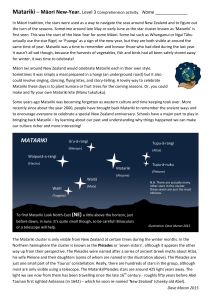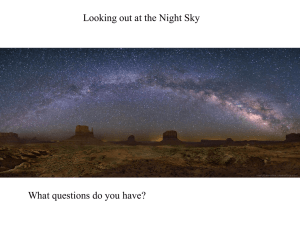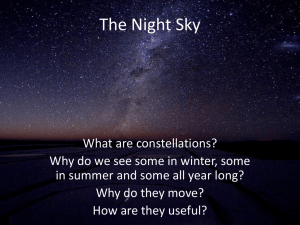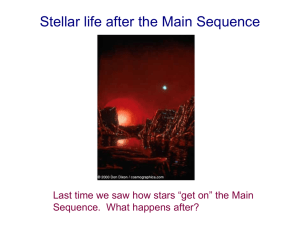Matariki-Maori New Year
advertisement
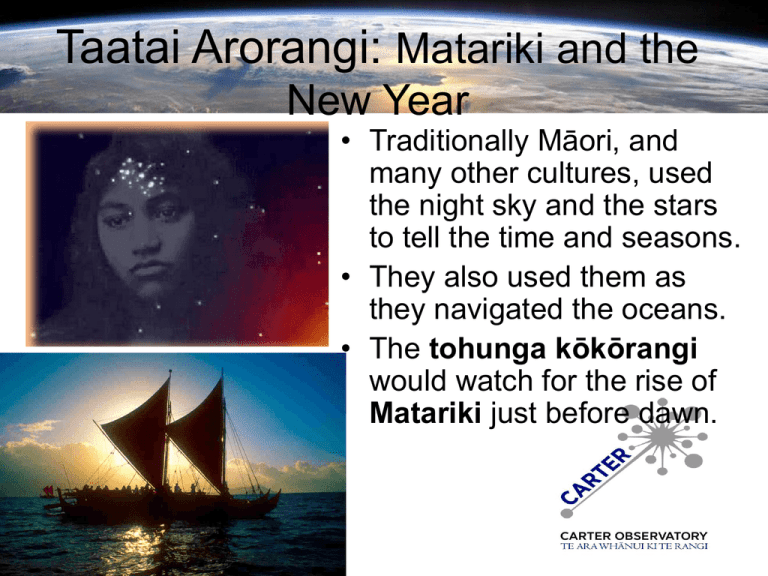
Taatai Arorangi: Matariki and the New Year • Traditionally Māori, and many other cultures, used the night sky and the stars to tell the time and seasons. • They also used them as they navigated the oceans. • The tohunga kōkōrangi would watch for the rise of Matariki just before dawn. Matariki and the New Year • Stories and legends were ways of passing knowledge from generation to generation. • Even if the cause was not understood the story explained observed events. • There may be many versions of a similar story. • Here is one story of Matariki • The rising of Matariki the Maori New Year and signalled a time for connecting, giving thanks to the land, sea and sky, a time for the community to come together to farewell those departed and acknowledge the year gone. • Matariki was also a time to turn to the future, welcoming the new generation to the world and planning for the year ahead. • It is universal to Maori and Pakeha, because we all live with the opposite seasons to the Northern hemisphere. • Matariki could be added to our celebrations calendar. It provides us with something that's unique. • The crops were planted according to the appearance of the Matariki star cluster. • If the stars were clear and bright, it was a sign of a favourable and productive season ahead, and planting would begin in September. • If the stars appeared hazy and closely bunched together, a cold winter was in store and planting was put off until October. • The Matariki were honoured by the Maori. The heliacal rising of that asterism was greeted by women with song and dance. • In other areas the cosmic rising of Rigel marked the beginning of the new year with a similar festival marking the event. The Helical rising of the Stars • New star patterns become visible as we travel around the Sun. • Matariki is in Taurus Heliacal risings occur after a star has been behind the Sun for a time and it is just returning to visibility. One morning, just before dawn, the star rises after its absence behind the Sun and is seen for a moment, then lost in the rising Sun’s glare. That one special morning is called the star's heliacal rising. Circumpolar stars will NOT work! • Not all stars have heliacal risings because some stars are always above the horizon and are called circumpolar stars. • Only certain stars rise, flash and twinkle in the predawn glow. El Niño or La Niña- watch out! • Clear, bright stars = a good season. • Hazy and bunched together= cold winter, planting delayed. • The upper atmosphere may indicate long term weather conditions. • Astute, practiced observers can see the difference from year to year. • Can you? The rising position of the Sun in a year Looking west this shows the Sun setting - from mid-winter through the equinox to mid-summer (Northern Hemisphere view). What dates are these? The Pleiades/Matariki star cluster facts • A cluster of around 1000 stars that are about 440 light years away (our Sun is 8 light minutes away) • The blue color is caused by blue light being scattered by dust. • The stars in the Pleiades are young100 million years old about 1/50th the age of our Sun •Merope, one of the brightest stars in the Pleiades- where the nebulosity is caused by a chance encounter between an open star cluster and a molecular cloud. • • • • 29.5 days makes a “Moonth” Maori followed a lunar calendar: Te Maramataka New Moon is when the Moon is between Sun and the Earth First quarter is when it has moved one fourth of it’s way around the Earth but it looks like a semi-circle and many call it a “half Moon”! • Full Moon comes half way through the cycle (Sun, Earth & Moon Alignment. • 29.5 days is not a factor of 365- which is why our months are a mix from 28 day to 31 day lengths In the Southern Hemisphere the sunlit part moves from the left to the right. C O D (C first quarter, O full Moon, D last quarter) Calendars, clocks and Time • How many trips around the Sun have you made? • What season were you born in? How many days, weeks, and “moonths” have you lived through? How do you know? Is it easy to count how many Moon cycles you have lived through? Is it years x12 or years x13 ? So how many Moonths old are you? Near, Far and IN-between.

